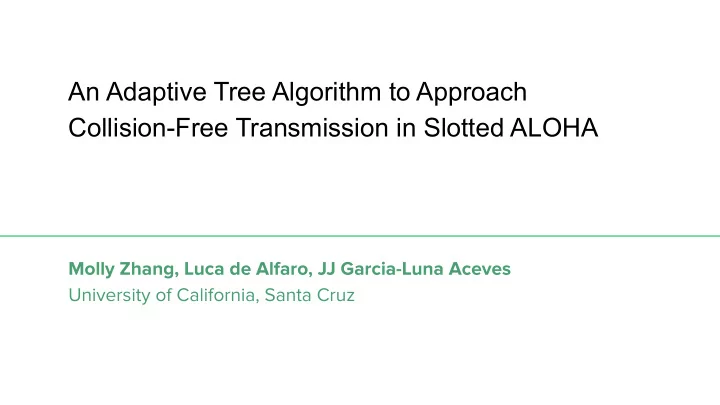

An Adaptive Tree Algorithm to Approach Collision-Free Transmission in Slotted ALOHA Molly Zhang, Luca de Alfaro, JJ Garcia-Luna Aceves University of California, Santa Cruz
Outline Problem Statement Adaptive Tree ALOHA Performance
Setting: Time-Slotted Channel Access User 1 User 2 User 3 time Channel
Goal: Learning Coordination in Channel Access ● Turn Taking ● High Network Utilization ● Avoid collisions ● Avoid empty time slots
History: ALOHA ALOHA protocol: User 1 Transmit when you like, and if there are User 2 collisions, retry. Max utilization ≈ 18% User 3 time Channel
History: Slotted ALOHA Slotted ALOHA protocol: User 1 Time divided to time slots. Transmit at the User 2 beginning of time slots. Max utilization ≈ 37% User 3 Channel
History: Slotted ALOHA with Exponential Backoff Exponential Backoff Transmit with probability p ● ● Collision: halves p ● Success: doubles p Max utilization ≈ 100% (very unfair condition)
Goal: Learning Coordination in Channel Access 1 Can we do better? 3 Can nodes learn to coordinate with Reinforcement Learning or Machine Learning? 2
Reinforcement Learning and Expert-based Learning
ALOHA-Q: Choosing transmission slot [Chu et al, 2012] ● Learn the weight of slots in a frame.
ALOHA-Q: Choosing transmission slot [Chu et al, 2012] Learn the weight of slots in a frame. ● ● Transmit in the highest-weight slot
ALOHA-Q: Choosing transmission slot [Chu et al, 2012] Learn the weight of slots in a frame. ● ● Transmit in the highest-weight slot Different nodes learns different slot ● Transmissions
ALOHA-Q: Choosing transmission slot [Chu et al, 2012] Problems: ● Frame length N selection ● Slow learning Transmissions
AT-ALOHA Guide learning and conflict resolution via a policy tree. (0, 0) ( i , m ) : transmit at time i every 2 m slots (0, 1) (1, 1) (0, 2) (2, 2) (3, 2) (1, 2)
AT-ALOHA Guide learning and conflict resolution via a policy tree. (0, 0) (0, 1) (1, 1) (0, 2) (2, 2) (3, 2) (1, 2)
AT-ALOHA Guide learning and conflict resolution via a policy tree. (0, 0) (0, 1) (1, 1) (0, 2) (2, 2) (3, 2) (1, 2)
AT-ALOHA Guide learning and conflict resolution via a policy tree. (0, 0) (0, 1) (1, 1) (0, 2) (2, 2) (3, 2) (1, 2) (1, 2) Every child transmits half the times of the parent.
AT-ALOHA Guide learning and conflict resolution via a policy tree. (0, 0) ● Nodes that are not one the descendant of the other do not conflict. ● Conflicts are rare. Coordination is facilitated. (0, 1) (1, 1) (0, 2) (2, 2) (3, 2) (1, 2) (1, 2)
AT-ALOHA Different nodes learn a different tree to co-exist conflict-free
Next: How do the AT-ALOHA nodes learn different trees ?
AT-ALOHA Update: Demotion After Collision p=0.5 p=0.5
AT-ALOHA Update: Demotion After Collision p=0.5 p=0.5
AT-ALOHA Update: barge into empty slots The barge-in probability p p is tuned based on the number of active nodes in a network. 1 − p = nodes that could have transmitted in time slot
AT-ALOHA Update: Normalization merge sibling nodes remove redundant descendants
AT-ALOHA Update Pruning to max depth and max number of nodes
AT-ALOHA: additional tuned parameters ➔ Maintaining 5% empty slots “Transmission Tax”: a node has to give up its transmission ◆ policy at a small probability ➔ Maintaining a constant (1.4) empty-to-collision ratio By tuning barge-in probability ◆ Maximize likelihood of only one transmitting into empty slot ◆
AT-ALOHA Performance Metric Network Utilization: Ratio of successful transmission ● Fairness Metric: Jain index ●
AT-ALOHA Performance ● 10 nodes -> 50 nodes -> 30 nodes High Utilization and Low Empty slots ● or Collisions throughout
AT-ALOHA Performance comparison Network Utilization ● AT-ALOHA ● EB-ALOHA: ALOHA with exponential backoff ● EB-ALL-ALOHA: ALOHA with exponential backoff applied to all nodes ● ALOHA-Q: Chu et al. AT-ALOHA has both high network Fairness utilization and high fairness under varying network conditions
Conclusions ● We introduced a “Adaptive Tree” ALOHA protocol. ● Learns to maintain high utilization and fairness under varying network condition (0, 0) (0, 1) (1, 1) (0, 2) (2, 2) (3, 2) (1, 2) (1, 2)
Thank you!
Recommend
More recommend